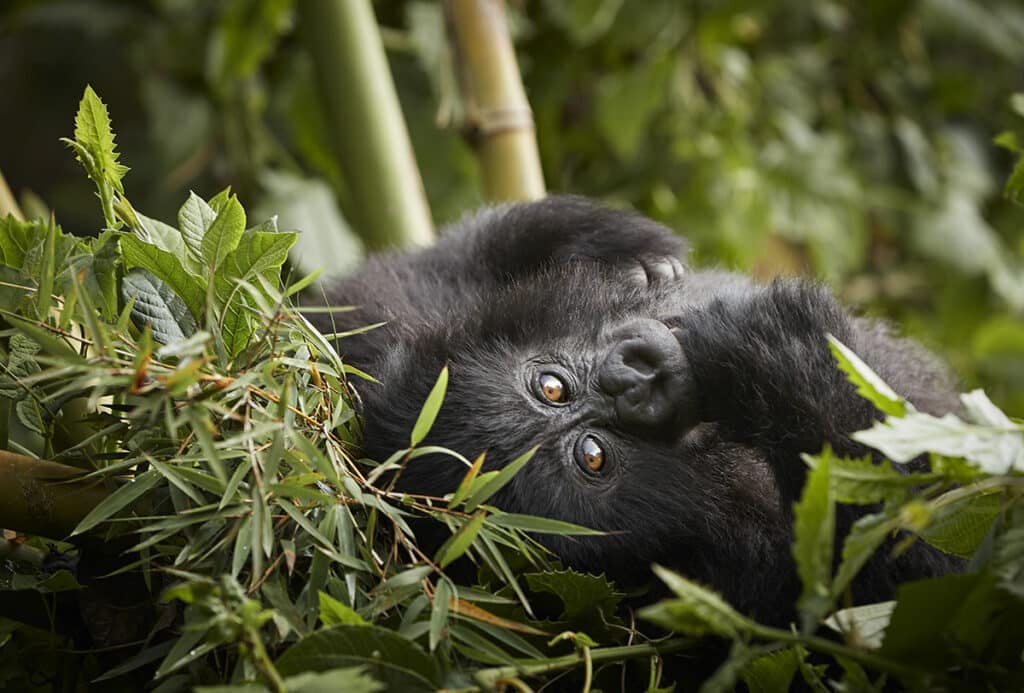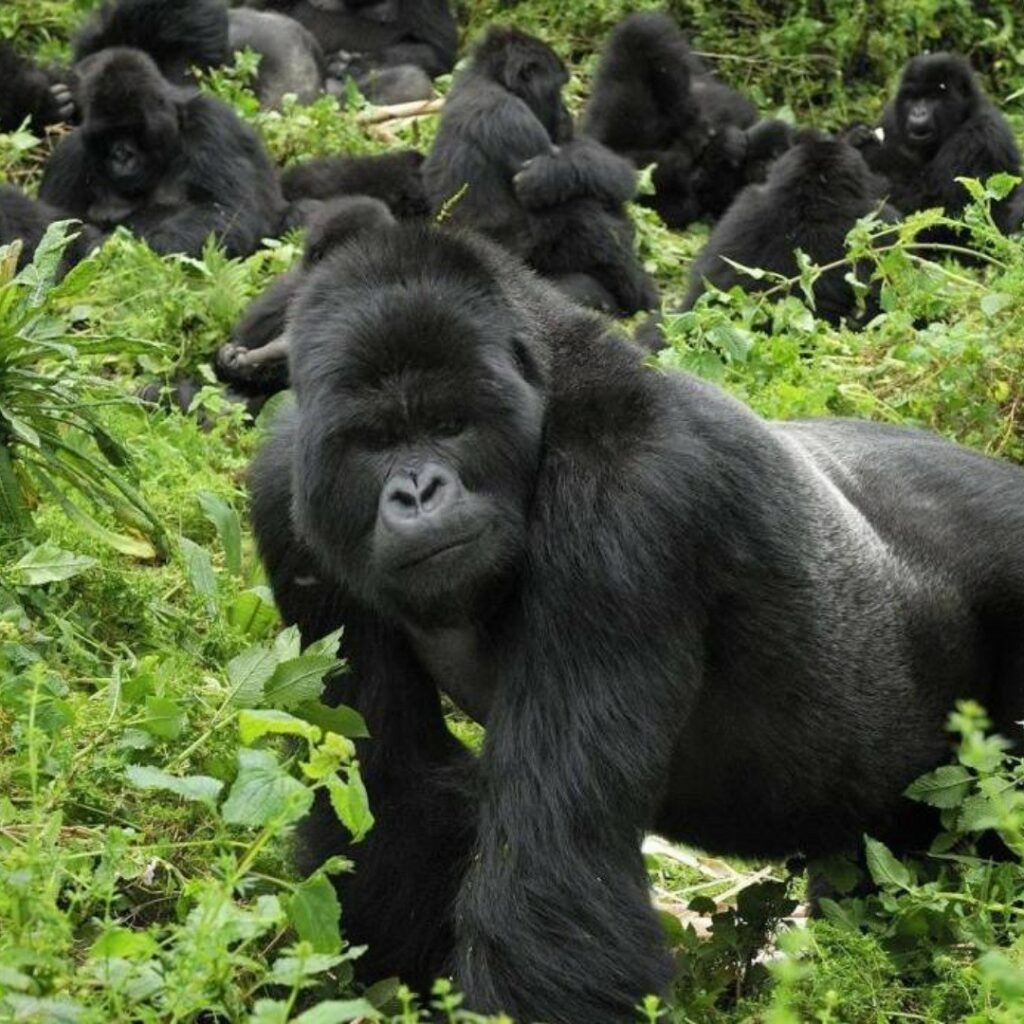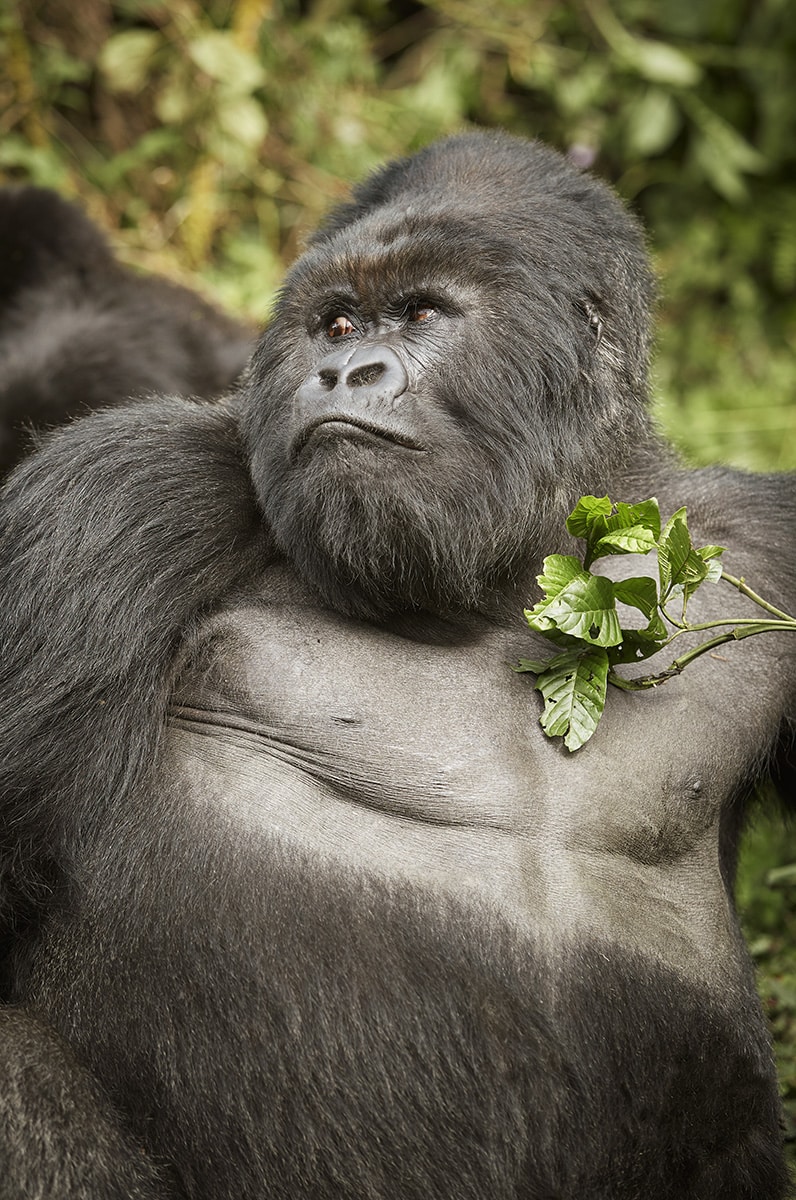Into the mists with the mountain gorillas
Grassy lowlands quickly lead up to the dense montane rainforest of the volcanoes; a mountainous spine stretching along the Albertine Rift between Rwanda, Uganda and the Democratic Republic of the Congo that ranges from 2,200 to 4,300 meters (7,200 to 14,100 feet) in height. The lush forest teems with wildlife including golden monkeys, buffalo, spotted hyena, duiker and bushbuck antelopes, over 100 species of birds, and even an occasional sighting of forest elephants. However, undoubtedly the most captivating of all of the rainforest’s residents is the mountain gorilla.
The largest of the great apes, gorillas share 98.3% of our DNA. Each family group comprises five to 50 individuals, including an alpha male (known as a ‘silverback’ due to their silvery coat stretching down to their hips), females and young gorillas. The impressive silverbacks weigh up to 200kg and stand up to two meters in height. A silverback will lead his troop for several years, determining where they forage for food and defending the family and its territory. Though there’s no specific mating season, courtship is an elaborate physical display between females and silverbacks (and sometimes other males). Gestation is around nine months and each female will likely have only a few young in her lifetime, meaning the rate of reproduction is low.

Gorillas live within an altitude of 2500 and 4000m. Within the Rwandan portion of Volcanoes National Park there are 12 habituated families, each closely guarded by park rangers. Each troop will see a maximum of eight visitors each day for one hour only and there are also several families who are never visited – predominantly to limit the risk of human pathogens spreading to the gorilla population – yet also kept under close observation and protection.
Conservation efforts have been successful, leading to the down-listing of the mountain gorilla from ‘critically endangered’ to ‘endangered’ in 2018. The population of Gorilla beringei beringei remains critically small with just 1,063 individuals; 604 live in the Virunga massif and the remainder divided between Bwindi Impenetrable Forest, Uganda, and the Sarambwe Reserve in the DRC). Numbers have steadily increased since the 1981 census when only 254 gorillas were recorded in Volcanoes National Park. Protection from poaching, disease and loss of habitat have been major contributing factors to this revival, and the controlled flow of visitors provides funding for local initiatives that help to ensure the gorillas survival.
High-end tourism in Rwanda has been critical to the stewardship of these primates and the preservation of their habitat, and it has also helped get the country back on its feet after the tragic events of 1994. Additionally, tourism initiatives have aided trans-boundary collaboration between Rwanda, Uganda and the DRC in their shared quest to continue to safeguard these beautiful creatures. The mountain gorillas are a great source of national pride with the Kwita Izina gorilla-naming ceremony being a major event celebrating the birth of each baby gorilla.

Visiting Volcanoes National Park
Volcanoes National Park encompasses 160 square kilometers on the northern edge of Rwanda and is a two to three hour drive from Kigali. It’s recommended that you wear sturdy walking boots, thick trousers and a long-sleeved shirt to protect you from stinging nettles and prickly vegetation. You might also want to bring a pair of gloves and a hat on your adventure…. and your camera of course! We’ll provide you with snacks and water.
You’ll arrive early in the morning at Volcanoes National Park headquarters for an introduction and a safety briefing before being divided into groups of eight people maximum and assigned a guide. Group assignments will depend on the fitness level and age of guests, so it’s important that you’re honest about your physical stamina and ability. The treks from the Park Headquarters can be very steep and long and last anywhere from 30 minutes to 4 hours + depending on the location of family allocated to your group, though of course efforts will be made to assign those less able to groups closer to the trailheads. Gorillas are wild animals and observing them in their natural habitat can be unpredictable. Your expert guide and park rangers will lead you up the volcano to track one of the troops through the dense forest. Porters are available to help carry backpacks and cameras, as well as helping you with your footing along your hike. Tracking can be hard work but it is, absolutely, worth the effort.
Once you locate the gorillas, you will spend an hour observing the silverback and his family at close range as they go about their daily life. Cliché though it sounds, this is an awesome and unique experience.
Visiting the gorillas in Rwanda
Currently, tourist permits to visit the endangered mountain gorillas in Rwanda cost $1500, which includes entry to the Volcanoes National Park and your guides.
If you have only one day to make this incredible journey, we offer A day with mountain gorillas. And for those with a little more time, why not stay overnight or combine it with a trip to Lake Kivu?
Visiting the gorillas in Uganda
As an alternative, you may wish to cross into Uganda to visit one of the gorilla families that live on the other side of the park on Mount Gahinga. Permits are significantly cheaper at $700 and, while the border crossing can take some time, it’s another adventure.
See both Rwanda’s golden monkeys and the mountain gorillas of Uganda in a trip to The Gorilla Highlands.
